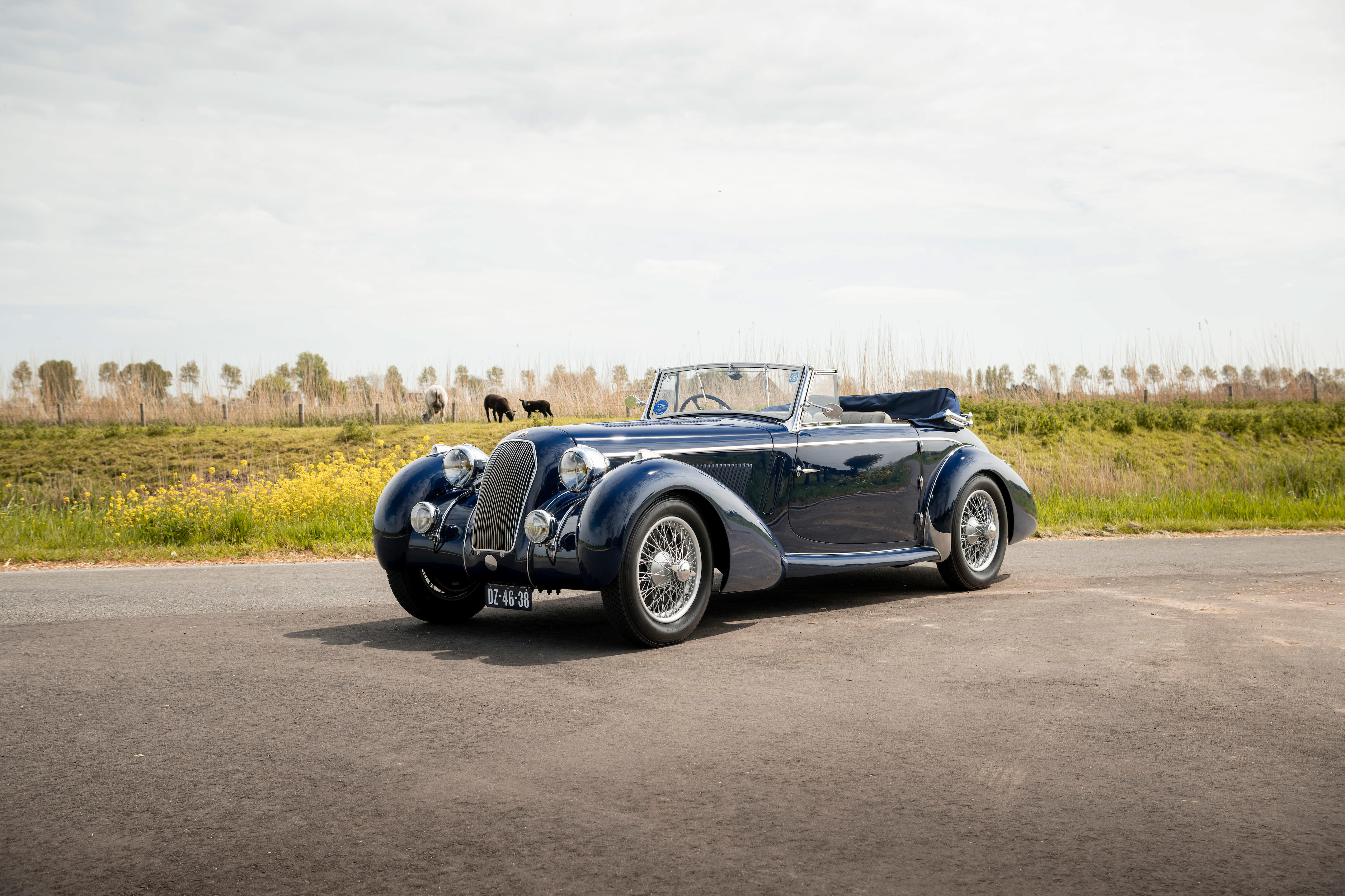By the early 1930s Ettore Bugatti had established an unrivalled reputation for building cars with outstanding performance on road or track; the world’s greatest racing drivers enjoying countless successes aboard the Molsheim factory’s products and often choosing them for their everyday transport. In 1927 Bugatti had produced the Type 43 Grand Sport - the first 100mph Grand Prix-engined sporting chassis suitable for everyday road use. It was in effect a close-coupled four-seater touring model powered by the supercharged Type 35B Grand Prix engine. Because of its lengthy run of success, Ettore Bugatti remained stubbornly committed to this single-cam engine, only adopting the more advanced double-overhead-camshaft method of valve actuation, after much prompting by his eldest son Jean on the Type 50 of 1930. From then on Jean Bugatti took greater responsibility for design, his first car being the exquisite Type 55 roadster, a model ranking among the finest sports cars of the 1930s. The Type 55’s 2,262cc, supercharged, twin-cam, straight-eight engine was carried over in slightly de-tuned form from the successful Type 51 Grand Prix car - successor to the legendary Type 35 - and fitted in the Grand Prix Type 54’s ladder frame chassis. The precocious Jean Bugatti added his own individual touch, designing a sublime two-seat roadster body that is universally acknowledged as one of the finest ever to grace an automobile. Unlike the Type 43, this new model was invariably a two-seater that was often referred to, quite justifiably, as the ‘Super Sport’. Aimed at only the wealthiest clientele, the Type 55 sold in commensurately limited numbers, a mere 38 being built between 1932 and 1935, the vast majority of these in the first year of production. Indeed, it truly was the ultimate exclusive supercar of the early 1930s. Even its closest rival, the 8C Alfa Romeo, was produced in far greater numbers, the majority of which were in long-chassis form and often fitted with four-seater coachwork. In contrast, almost half of the 38 Type 55 Bugattis built were fitted with Jean Bugatti designed roadster or closed coupé coachwork, the classic roadster being considered by many cognoscenti to be by far the most outstandingly attractive sports car ever offered to the motoring public. Chassis number ‘55208’, fitted with engine number ‘12’, was completed in chassis form in February 1932 before being invoiced by the factory on 14th April 1932 for delivery to their Parisian agent Dominique Lamberjack. Priced at 72,500 francs, it was one of five Type 55 chassis delivered to Lamberjack. According to the factory records it was fitted with ‘Roadster Luxe’ coachwork executed presumably either by the factory or by their close associates Gangloff of Colmar, no doubt to the order of its original owner who is thought to have been the French amateur racing driver Charles Brunet. A photograph of the newly delivered car, surrounded evidently by members of the Brunet family, shows it with the temporary registration number ‘4954 W12’. The next record of the car is when it took part in the 1934 Le Mans 24-Hour race, entered by Brunet who shared the driving with Freddie Zehender. Allocated race No. 14, the Bugatti was running in a strong 5th place when, on its 75th lap at around midnight, it spun out of contention when avoiding a crashed competitor. A photograph of the car with No. 14 on its door and Brunet at the wheel before the start shows that it had been fitted with leather bonnet straps for the event but was otherwise unchanged in appearance. A later photograph of the car in Hugh Conway’s Bugatti book shows it with the temporary registration number ‘4452 W12’ and still with the bonnet straps and race No. 14 on its radiator core. Over the next few years the car’s history becomes less clear. It was reportedly left standing in Monaco for a long period, possibly throughout the war years, before being acquired by a Frenchman named Pijer living near Lyon. A photograph of the
By the early 1930s Ettore Bugatti had established an unrivalled reputation for building cars with outstanding performance on road or track; the world’s greatest racing drivers enjoying countless successes aboard the Molsheim factory’s products and often choosing them for their everyday transport. In 1927 Bugatti had produced the Type 43 Grand Sport - the first 100mph Grand Prix-engined sporting chassis suitable for everyday road use. It was in effect a close-coupled four-seater touring model powered by the supercharged Type 35B Grand Prix engine. Because of its lengthy run of success, Ettore Bugatti remained stubbornly committed to this single-cam engine, only adopting the more advanced double-overhead-camshaft method of valve actuation, after much prompting by his eldest son Jean on the Type 50 of 1930. From then on Jean Bugatti took greater responsibility for design, his first car being the exquisite Type 55 roadster, a model ranking among the finest sports cars of the 1930s. The Type 55’s 2,262cc, supercharged, twin-cam, straight-eight engine was carried over in slightly de-tuned form from the successful Type 51 Grand Prix car - successor to the legendary Type 35 - and fitted in the Grand Prix Type 54’s ladder frame chassis. The precocious Jean Bugatti added his own individual touch, designing a sublime two-seat roadster body that is universally acknowledged as one of the finest ever to grace an automobile. Unlike the Type 43, this new model was invariably a two-seater that was often referred to, quite justifiably, as the ‘Super Sport’. Aimed at only the wealthiest clientele, the Type 55 sold in commensurately limited numbers, a mere 38 being built between 1932 and 1935, the vast majority of these in the first year of production. Indeed, it truly was the ultimate exclusive supercar of the early 1930s. Even its closest rival, the 8C Alfa Romeo, was produced in far greater numbers, the majority of which were in long-chassis form and often fitted with four-seater coachwork. In contrast, almost half of the 38 Type 55 Bugattis built were fitted with Jean Bugatti designed roadster or closed coupé coachwork, the classic roadster being considered by many cognoscenti to be by far the most outstandingly attractive sports car ever offered to the motoring public. Chassis number ‘55208’, fitted with engine number ‘12’, was completed in chassis form in February 1932 before being invoiced by the factory on 14th April 1932 for delivery to their Parisian agent Dominique Lamberjack. Priced at 72,500 francs, it was one of five Type 55 chassis delivered to Lamberjack. According to the factory records it was fitted with ‘Roadster Luxe’ coachwork executed presumably either by the factory or by their close associates Gangloff of Colmar, no doubt to the order of its original owner who is thought to have been the French amateur racing driver Charles Brunet. A photograph of the newly delivered car, surrounded evidently by members of the Brunet family, shows it with the temporary registration number ‘4954 W12’. The next record of the car is when it took part in the 1934 Le Mans 24-Hour race, entered by Brunet who shared the driving with Freddie Zehender. Allocated race No. 14, the Bugatti was running in a strong 5th place when, on its 75th lap at around midnight, it spun out of contention when avoiding a crashed competitor. A photograph of the car with No. 14 on its door and Brunet at the wheel before the start shows that it had been fitted with leather bonnet straps for the event but was otherwise unchanged in appearance. A later photograph of the car in Hugh Conway’s Bugatti book shows it with the temporary registration number ‘4452 W12’ and still with the bonnet straps and race No. 14 on its radiator core. Over the next few years the car’s history becomes less clear. It was reportedly left standing in Monaco for a long period, possibly throughout the war years, before being acquired by a Frenchman named Pijer living near Lyon. A photograph of the









Try LotSearch and its premium features for 7 days - without any costs!
Be notified automatically about new items in upcoming auctions.
Create an alert